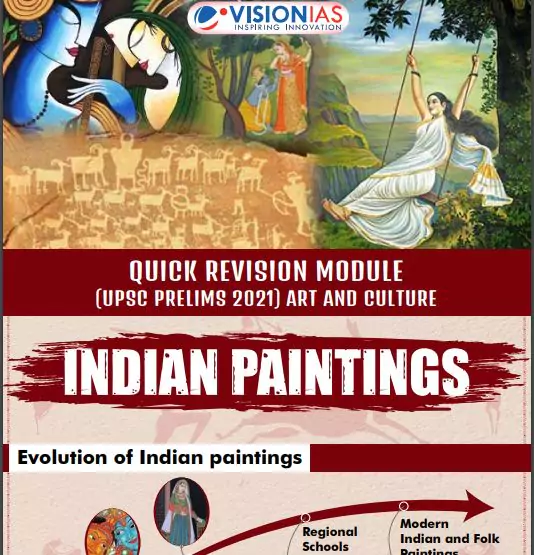‘Famous Indian Painting Upsc Notes PDF’ PDF Quick download link is given at the bottom of this article. You can see the PDF demo, size of the PDF, page numbers, and direct download Free PDF of ‘Indian Painting Upsc Notes PDF’ using the download button.
Indian Painting Upsc Notes PDF Free Download

Indian Painting Upsc Notes
Brief history of Painting in India
Indian painting has a very long tradition and history in Indian art, though the cause of the climatic conditions very few early examples survive.
The earliest Indian paintings were the rock paintings of pre-historic times, the petroglyphs as found in places like Bhimbetka rock shelters, and some of the Stone Age rock paintings found among the Bhimbetka rock shelters are approximately 10,000 years old.
India’s ancient Hindu and Buddhist literature has many mentions of palaces and other buildings decorated with paintings, but the paintings of the Ajanta Caves are the most significant of the few survivors.
Smaller scale painting in manuscripts was probably also practiced in this period, though the earliest survivors are from the medieval period.
A new style was introduced with Mughal painting, representing a fusion of the Persian miniature with older Indian traditions, and from the 17th century its style was diffused across Indian princely courts of all religions, each developing a local style.
Company paintings were made for British clients under the British raj, which from the 19th century also introduced art schools along Western lines, leading to modern Indian painting, which is increasingly returning to its Indian roots.
Indian paintings can be broadly classified as murals, miniatures, and paintings on cloth.
Murals are large works executed on the walls of solid structures, as in the Ajanta Caves and the Kailashnath temple.
Miniature paintings are executed on a very small scale for books or albums on perishable material such as paper and cloth.
Traces of murals, in fresco-like techniques, survive in a number of sites with Indian rock-cut architecture, going back at least 2,000 years, but the 1st and 5th-century remains at the Ajanta Caves are much the most significant.
Prehistoric Rock Art
The pre-historic paintings were generally executed on rocks and these rock engravings were called Petroglyphs.
These paintings generally depict animals like bison, beer and tigers, etc.
The oldest Indian paintings are rock art in caves which are around 10,000 years old, such as the Bhimbetka cave paintings.
Murals
The history of Indian murals starts in ancient and early medieval times, from the 2nd century BC to 8th – 10th century AD.
There are known more than 20 locations around India containing murals from this period, mainly from natural caves and rock-cut chambers.
The highest achievements of this time are the caves of Ajanta, Bagh, Sittanavasal, Armamalai Cave (Tamil Nadu), Ravan Chhaya rock shelter, and Kailasanatha temple in Ellora Caves.
Murals from this period depict mainly religious themes of Buddhist, Jain, and Hindu religions.
There are though also locations where paintings were made to adorn mundane premises, like the ancient theatre room in Jogimara Cave and possible royal hunting lodge circa 7th-century AD – Ravan Chhaya rock shelter.
The pattern of large-scale wall painting which had dominated the scene witnessed the advent of miniature paintings during the 11th and 12th centuries.
This new style was figured first in the form of illustrations etched on palm-leaf manuscripts.
The contents of these manuscripts included literature on Buddhism and Jainism. In eastern India, the principal centers of artistic and intellectual activities of the Buddhist religion were Nalanda, Odantapuri, Vikramshila, and Somarpura situated in the Pala kingdom (Bengal and Bihar).
Painting under the Sultanate of Delhi
Despite Islamic injunctions against anthropomorphic figures in art, the Delhi Sultanate patronized vast cannons of painting and artistic work.
The Delhi Sultanate developed an Indo-Persian style of painting that drew heavily from schools in Iran and Jain paintings.
Features of Delhi Sultanate paintings that are based on Indian traditions include groups of people standing in rows and identical poses, narrow bands of decoration running across the width of the painting, and bright and unusual colors.
The paintings of the Delhi Sultanate represent a period of inventiveness that set the stage for the development of the Mughal and Rajput schools of art, which thrived from the 16th to the 19th centuries.
Mughal Painting
Mughal painting is a style of Indian painting, generally confined to illustrations in the book and done in miniatures, and which emerged, developed, and took shape during the period of the Mughal Empire between the 16th and 19th centuries.
The Mughal style was heavily influenced by Persian miniatures, and in turn influenced several Indian styles, including the Rajput, Pahari and Deccan styles of painting.
Mughal paintings were a unique blend of Indian, Persian, and Islamic styles. Because the Mughal kings wanted visual records of their deeds as hunters and conquerors, their artists accompanied them on military expeditions or missions of state, or recorded their prowess as animal slayers, or depicted them in the great dynastic ceremonies of marriages.
” Akbar’s reign (1556–1605) ushered a new era in Indian miniature painting.
After he had consolidated his political power, he built a new capital at Fatehpur Sikri where he collected artists from India and Persia.
He was the first monarch who established in India an atelier under the supervision of two Persian master artists, Mir Sayyed Ali and Abdus Samad.
Earlier, both of them had served under the patronage of Humayun in Kabul and accompanied him to India when he regained his throne in 1555.
More than a hundred painters were employed, most of whom were from Gujarat, Gwalior and Kashmir, who gave a birth to a new school of painting, popularly known as the Mughal School of miniature Paintings.
| Author | – |
| Language | ENGLISH |
| No. of Pages | 17 |
| PDF Size | 3 MB |
| Category | Education |
| Source/Credits | cloudfront.net |
Indian Painting Upsc Notes PDF Free Download
